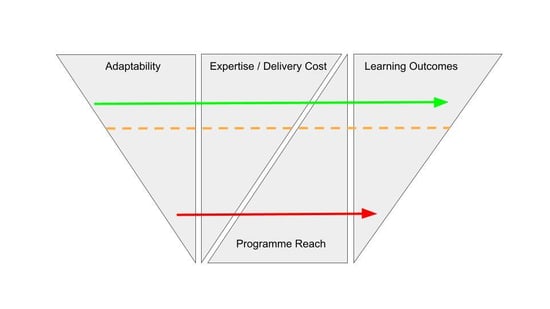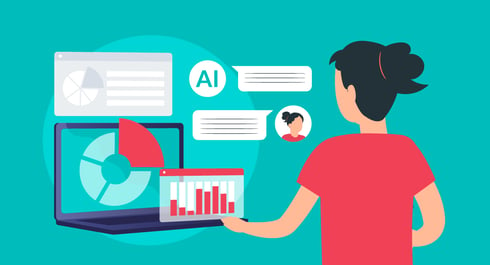Note: This blog should be read in conjunction with Lena’s story which seeks to convey what is currently possible with AI and what will be achieved in the near future.
Introduction
The "AI revolution" evokes a range of emotions, from excitement to dread, depending on one’s outlook and penchant for dystopian novels.
For those of us in both education and technology sectors, the task falls on our shoulders to guide schools in separating meaningful advancements from hype. Though many claims about new technology lack substantial proof of effectiveness, there are moments when we must spotlight emerging developments of great significance.
Among these significant advancements, practical artificial intelligence, particularly large language models (LLMs), stand out as perhaps the most transformative in the educational landscape. The potential implications go far beyond immediate concerns about chatbots compromising assessment.
Before delving into these educational implications, it's important to ask: What is the fundamental unit of value that this AI revolution brings? Previous technological shifts like the internet democratised access to information, while mobile technology changed the way we connect and create. What, then, will AI transform?
Though time-saving and resource creation are currently top of mind, we argue that the real transformative value lies in "democratising sense."
Making sense
The internet and mobile revolutions brought with them an overwhelming deluge of data and competing viewpoints. This information overload leaves us with two unappealing options: endure the mental strain of sifting through it all, or selectively choose a preferred source and disregard the rest.
What if there was a better way? Imagine having a personalised or organisational interpretive framework that could sift through this vast amount of data based on our priorities and values. This would allow us to cut through the noise and focus on actionable insights. Most importantly this framework will be able to undertake this role cost effectively at scale.
This ability to democratise sense-making is the core transformation that AI offers. Over time, this aspect will likely have the most profound impact on both society and the economy. It will be as disruptive as the industrial and information revolutions were, affecting many roles that primarily involve making sense of the world. However, it also opens up opportunities. Making sense is not an automated process; it requires curation in and for human contexts. Just as workers adapted during the industrial revolution, so too will we refine these new tools for sense-making.
Among various professions, educators are perhaps the least immediately impacted. Community and connection remain as important as ever, and there's still a societal need for childcare (don't shoot the messenger). While AI won't replace educators in the near future, the tools and methodologies they use will undergo significant transformations. This is because AI will enable scalable sense-making, making it possible to achieve the often elusive goals of instructional design.
Building Adaptivity
Effective adaptation is directed by insight/sense. The ability to interpret learning needs at scale opens the door to scalable adaptivity in educational programs— providing adaptive instruction and feedback for each learner, but without the prohibitive costs usually associated with such customisation. This comes with far-reaching consequences.
The Traditional Dilemma
 Traditionally, more adaptability in a learning program equates to improved learning outcomes. This makes sense; the more you can adapt the learning experience based on prior knowledge and context, the more effective it will be. Personalised feedback, likewise, has a greater impact. The downside is that this level of customization comes at a price: It demands specialised expertise to identify individual learning needs and then tailor activities accordingly.
Traditionally, more adaptability in a learning program equates to improved learning outcomes. This makes sense; the more you can adapt the learning experience based on prior knowledge and context, the more effective it will be. Personalised feedback, likewise, has a greater impact. The downside is that this level of customization comes at a price: It demands specialised expertise to identify individual learning needs and then tailor activities accordingly.
In short, if each student could have their own high-quality teacher or coach, learning outcomes would certainly improve. But this would skyrocket program delivery costs and reduce its reach. The alternative—offering minimally adaptable programs with standardised content to cut costs—risks losing effectiveness.
AI changes this equation. It has the potential to understand complex learning needs and automatically adjust teaching methods accordingly. Importantly, this adaptability becomes more cost-effective as the number of learners increases.
A Blended Approach
Incorporating AI into a learning program doesn’t have to be an isolated move. It can be part of a comprehensive support network that includes traditional classroom interactions and social learning components. In this blended model, learners can engage with teachers as they normally would while also benefiting from AI-powered tools for immediate feedback and practice. This dual approach not only enhances the learning experience but also empowers educators by providing real-time formative assessment data and intelligent teaching recommendations.
These advances have system-wide repercussions on course design, teacher support, and student guidance which is discussed in greater detail here by the US Department of Education Technology. Despite the obvious potential benefits, the pace of sector wide transformation is hard to predict, as there are a number of factors which may inhibit spread, not least the lack of coherence with existing systems of assessment.
AI for Teacher Professional Development
While the broader education system may take time to adapt to the potential of AI, there’s good reason to think teacher training and professional development (PD) are likely to be the first areas to undergo transformation.
- The urgency and importance of improving teacher quality cannot be overstated. High-quality teaching is pivotal for student success, but existing PD programs fall significantly short. Like general education, PD programs often face the adaptability-versus-scalability dilemma.
- Many existing PD programs neither alter teaching practices nor affect learning outcomes. Even those programs that make a difference, such as instructional coaching, are hamstrung by their high costs. It's a far-fetched idea to think that high-quality coaching can be made available to all teachers, given the resource constraints.
- This is especially true in a global context. By 2030, 90 million new teachers will require training, primarily in countries where the average household income is below $4,000 per year. High-quality, one-on-one coaching is financially and logistically unfeasible on this scale.
AI can solve these challenges by providing scalable, high-quality teacher training, making quality education more accessible globally.
The Need for Sense in Teacher PD
The challenges facing teachers who aim to enhance their instruction are multifaceted and immense. Consider a typical classroom: over 30 diverse learners, each producing educational artefacts, interacting with peers, engaging with the curriculum, and requiring individualised guidance—all under the supervision of a single teacher. This intricate dance is replayed up to five times a day. From this ocean of data, both the teacher and any supporting instructional coach must pinpoint the most impactful changes to teaching methods—all while the act of teaching is ongoing. The fact that this is done with any degree of effectiveness attests to the extraordinary commitment of educators and professional development specialists.
The complexity doesn't end here. Teachers themselves are a diverse group, each with unique skills, experiences, and mental models. If we need to be effective we need to notice and adapt to these traits. For instance, less experienced teachers may benefit most from a structured, skill-focused coaching program, whereas those with effective mental models and fluid skills may find greater value in a flexible and reflective learning environment.
Given current resources, it's nearly impossible to account for the multifaceted needs of every teacher within such a varied community. This leads many professional development programs to settle for generic, one-size-fits-all approaches that are often ineffective.
AI: A Transformative Solution for Teacher PD
Artificial Intelligence (AI) offers groundbreaking solutions to these challenges. For instance, AI can analyse classroom videos to identify specific learning obstacles and recommend targeted professional development for teachers. It can not only direct teachers to the most relevant educational content but also deliver it at times when they are most receptive. This is more than mere content delivery; AI can construct a tailored learning program based on a teacher's current expertise and the complexity of the skills they need to develop.
Moreover, AI can facilitate deliberate practice through adaptive scenarios, allowing teachers to rehearse new skills and receive immediate feedback. They can then take these new strategies into their classrooms, equipped with support materials and prompts co-developed with the AI. As teachers implement and refine these strategies, AI can continue to offer real-time feedback, further optimising instructional effectiveness.
To delve deeper into these potential applications—as well as to understand what is feasible with today's technology—please consider our example of Lena, whose story offers practical insights into the transformative role AI can play in teacher professional development.
The first iteration of AI tools are now live on IRIS Connect
We are excited to say that we have launched the first iteration of AI tools for instructional coaching and reflection.
- Teachers get actionable lesson feedback within seconds
- Coaches focus their valuable time on in-depth, targeted support
- Leaders provide personalised PD despite capacity limits
Find out more about our AI tools here as well as exclusive offers.



Leave a comment:
Get blog notifications
Keep up to date with our latest professional learning blogs.